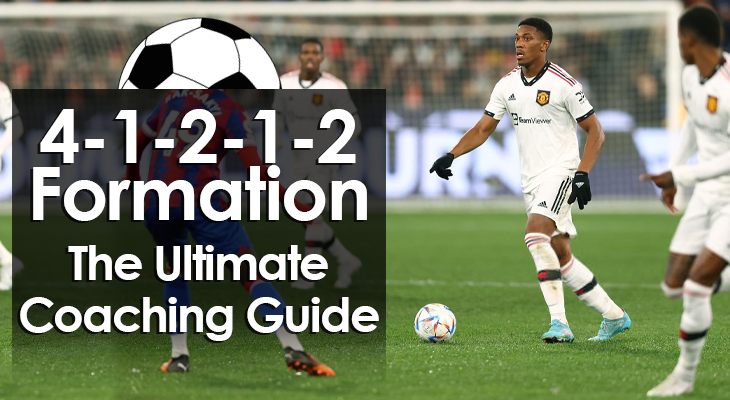4-1-2-1-2 Formation: The Ultimate Coaching Guide
Formations and tactical setups have always been critical aspects of a successful soccer team.
One of the most popular formations in modern soccer is the 4-1-2-1-2.
It's essentially a variation of the traditional 4-4-2, with midfielders taking on more specialized roles.
One midfielder sits in front of the defense, offering cover, while also being responsible for contributing to ball retention and buildup play.
The other takes on a playmaking role and has limited defensive responsibilities.
Depending on the strengths of the individual players, teams can execute a range of strategies in this formation.
This is one of the key advantages of this shape.
It's versatile and extremely balanced, facilitating a wide variety of offensive and defensive tactics.
In this article, I break down the core components of a 4-1-2-1-2, giving you the information and tools needed to set out your team in this shape.
What is a 4-1-2-1-2 Formation?
The 4-1-2-1-2 is a balanced and versatile shape that allows you to defend compactly, attack through the middle, or stretch the opposition along the wings.
How the system works depends largely on the tactics and style of play you, as a coach, want to implement.
On paper, the 4-1-2-1-2 formation looks relatively straightforward.
Each player has roles and responsibilities that align with traditional positional systems.
That said, the success of this shape comes down to finding the right players to fill each slot, as well as individual and collective execution of the strategy.
Any team can successfully implement the 4-1-2-1-2 through hard work on the training field, incorporating situational drills in both attack and defense, passing rondos, and positioning practice, in addition to standard skill work.
Some teams utilize their defensive midfielder (CDM) as a deep-lying playmaker, orchestrating attacks from behind the halfway line.
Other teams rely heavily on the attacking midfielder, or number 10, to create goalscoring opportunities.
However, to reap the full benefits of the 4-1-2-1-2 formation, there are certain qualities that your team should have:
Defensive Midfielder -- A positionally sound defensive midfielder adept at defense, retaining the ball well, and making line-breaking passes.
Attacking Midfielder -- An efficient attacking midfielder, capable of progressing the ball with both passing and dribbling.
Wingers -- Two-dimensional wingers that can produce in the final third without neglecting their defensive duties.
Center backs -- A cohesive center back partnership where both players understand each other’s strengths and weaknesses (consistent pairings are essential for this).
Fullbacks -- Defensively astute fullbacks that offer center back cover when the ball is on the opposite flank.
Strikers -- Strikers who complement each other’s playing styles.
Others -- At least four players who can play the attacking roles (in case of injuries or suspensions throughout the season).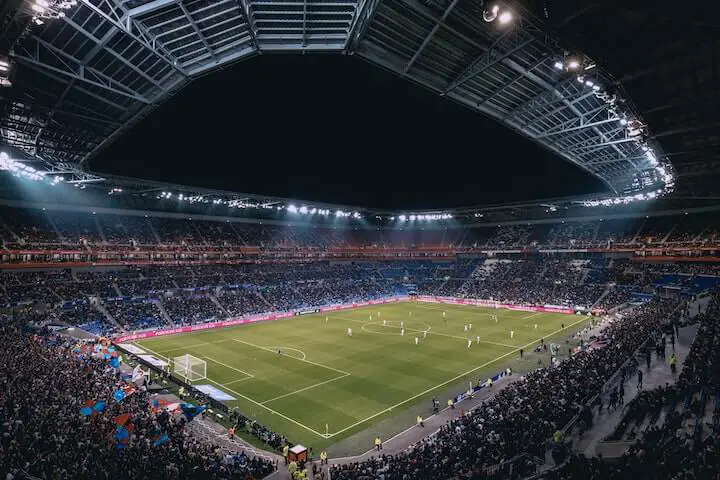
4-1-2-1-2 Formation Strengths
#1. Spacing
In soccer, there is a lot of strength in simplicity, especially when it comes to tactics.
The 4-1-2-1-2 formation is relatively straightforward, so it shouldn’t take long for players to adapt.
This balanced formation ensures players occupy almost every section of the field at all times.
The setup uses the full dimensions of the pitch to stretch the opposition.
However, to bridge gaps, it also relies on key partnerships between wingers and fullbacks, dual strikers, and center back pairings.
#2. Attacking Options
Dual-striker partnerships are a center back’s worst nightmare.
Pairing attackers creates mismatches and keeps central defenders occupied at all times.
Dual attackers also provide long ball outlets from wingers, midfielders, and defenders.
The CAM is also an important attacking threat in a 4-1-2-1-2.
With limited defensive responsibilities, the attacking midfielder’s sole purpose is to exploit gaps and create chances.
They often have a free role and can complete the triple threat by sitting just behind both strikers.
Attacking fullbacks can provide width and with support from midfield, you can create strong offensive phases from wide areas.
#3. Counterattacks
If your team is struggling to sustain meaningful attacks, the 4-1-2-1-2 formation provides the perfect springboard for counterattacks.
Its balanced structure allows players to transition quickly from defense to attack both centrally and in wide areas.
Two striker partnerships are a centerback’s worst nightmare.
Pairing attackers creates mismatches and keeps central defenders occupied at all times.
Dual attackers also provides long ball outlets from wingers, midfielders, and defenders.
#4. Solid Defensive Structure
A four-player backline provides a strong spine for the team.
This is especially so with two complementary and reliable center backs.
The CDM also offer blanketed cover, shielding center backs, and snuffing out opposition attacks before they can materialize.
What’s more, the CDM can drop between the center backs in and out of possession, further strengthening the line when defending a lead.
The deep-lying midfielder is also key in establishing attacks.
They find pockets of space in midfield and orchestrate attacks in the buildup phase.
#5. Versatility
The 4-1-2-1-2 formation gives coaches tactical flexibility.
They can easily restructure to a narrower variation or a 4-4-2 setup without substitutions.
Moreover, the midfield can be set up with a central or wide focus, depending on the opposition or the mode of attack you prefer.
Since it doesn’t involve many nuances, strategic changes should be relatively easy to execute.
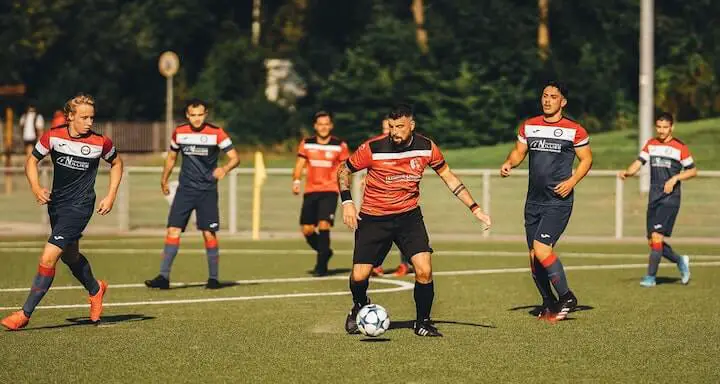
4-1-2-1-2 Formation Weaknesses
#1. Reliance on the CDM
A lot of pressure falls on the CDM’s shoulders.
They are the shield for the backline and can get outnumbered easily by more compact teams.
Moreover, the CDM must also be available as a passing outlet at all times -- often under tremendous pressure from opposing midfielders or with their back to goal.
#2. Can be Exploited on the Counter
Spacing can help expose opponents but it can also leave teams vulnerable to rapid counterattacks.
Failing to fall back into shape after losing possession often leaves large gaps in this formation.
This makes it virtually impossible to stop a well-worked counter.
Many modern teams use a three-player midfield, which can cause numerical mismatches and central overloads.
#3. Players Must be Competent in Possession
Players often find themselves isolated in the 4-1-2-1-2 formation, particularly in central areas.
They must be calm under pressure and display competency in possession.
If your outfielders lack composure on the ball, they’re likely to struggle in this shape.
All players must have a certain level of ability in possession.
To reap the full benefits of this system, teams must transition seamlessly between attack and defense.
Players constantly fight for space, be it through counterattacks or swift defensive recovery runs.
#4. Vulnerable to a High Press
The lack of numbers in midfield means teams in this shape can fall victim to an effective high press.
If the opposition marks the DM closely, center backs may struggle to find forward passes.
If they do, they run the risk of losing the ball in dangerous positions.
#5. Requires Multiple Strikers in Rotation
With two strikers on the field at all times, teams must have depth in terms of attacking options.
Otherwise, one or two injuries to attackers can force them into compromising their tactical shape.
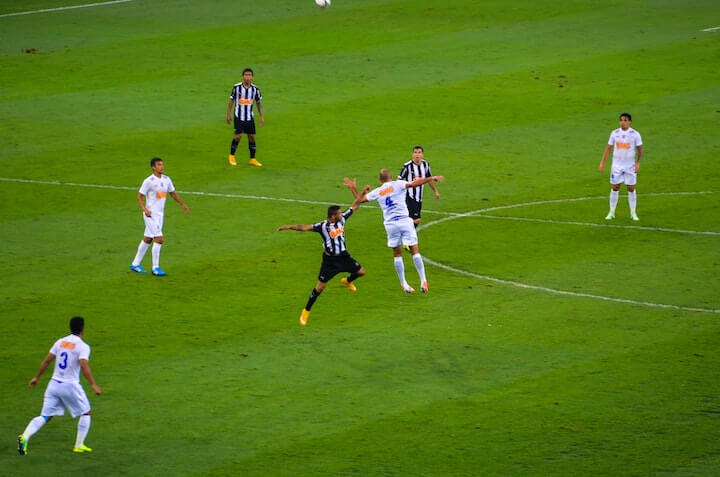
How to Play the 4-1-2-1-2 Formation
The beauty of a 4-1-2-1-2 formation is the solid defensive structure and variety of attacking options it offers.
That said, considering the individual responsibilities of each player, the coach must impart precise instructions to the team to ensure everything runs smoothly.
Here’s a look at how your team should operate in a 4-1-2-1-2.
4-1-2-1-2 Formation Setup
One of the strongest features of the 4-1-2-1-2 formation is the presence your team has between the lines (space between the midfield and defense or midfield and forwards).
In the modern game, these are the areas most teams look to exploit.
So, if you like what you’ve read so far, the next step is to learn how to attack and defend in this formation.
Attacking in the 4-1-2-1-2 Formation
As discussed, the 4-1-2-1-2 formation provides plenty of avenues to attack.
However, as a coach, you need to give your players clear instructions on how to build an offense.
Otherwise, the game can descend into chaos.
While some freedom is good, you should always play with strategy.
1. Attack in Numbers
While the shape thrives on space utilization, there are key partnerships and pairings all over the field to nullify threats and open up numerous angles to score from.
On the flanks, the fullbacks and wingers are in constant motion, attacking and defending as a unit.
With two strikers, this formation allows teams to create from wide areas, with wingers, fullbacks, and attacking midfielders.
Going forward, you must commit numbers or you risk leaving the striker isolated.
2. Play Through the Core Midfielders
The midfield anchor and central attacker are fundamental to everything the team does.
Your CDM and CAM should be the primary ball players, with the other midfielders operating as link players.
Get the ball to your influential midfielders early and often to allow them to impact the game.
These are your onfield generals and should be tasked with dictating the tempo of the match.
3. Instruct the Fullbacks to Attack
Attacking fullbacks are very important in this shape.
While your midfielders are the go-to players for buildup play, your team needs an out ball.
Attacking fullbacks stretch the opposition, creating more space all over the field.
When you commit players forward, the fullbacks have targets in the penalty box to aim for with crosses.
Defending in the 4-1-2-1-2 Formation
The 4-1-2-1-2 has everything you want to implement modern defensive tactics.
Its balance and spacing ensure you can shut up shop when needed.
Moreover, the positioning of key players gives you cover in all areas.
Here are three tips for defending successfully in the 4-1-2-1-2.
1. High-Press
With two strikers and a CAM just behind them, you can press aggressively in this shape.
Usually, the press is triggered by a pass to the “weakest” ball-playing defender.
Most teams then force the ball out wide and try to pin the opposition along the sideline.
However, since the 4-1-2-1-2 can be vulnerable to counterattacks, it’s important to reset as soon as the press is beaten.
2. Compact Backline
The center back pairing works together as with any four-player backline.
Both defenders are in continuous communication with the DM, ensuring they're in the right position to block passing lanes or drop deep to sure up the backline.
Out of possession, the backline should be compact, eliminating any obvious gaps.
3. Mid-Block
When the other team has the ball, it’s important not to retreat too far back.
A mid-block is where you set a firm defensive line in the middle third of the field.
Establishing a mid-block out of possession puts a lot of numbers between your opponents and your goal.
It allows you to win the ball back higher up the field and limiting access to dangerous areas near your goal.
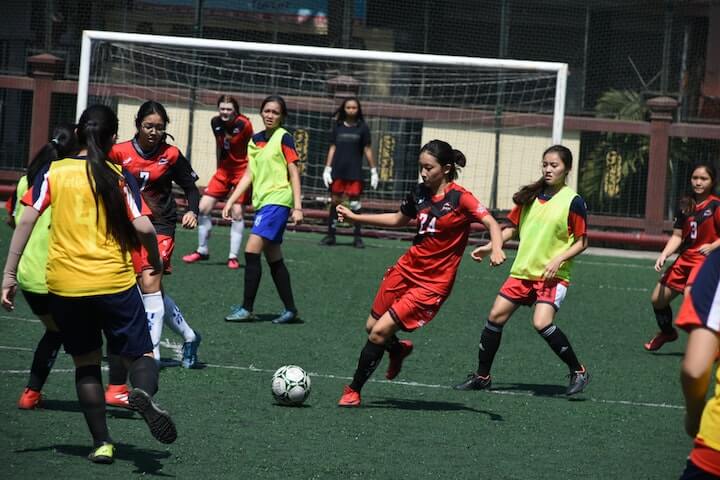
Individual Position Responsibilities
Goalkeeper
The goalkeeper’s primary role is straightforward: prevent the opposition from scoring.
A goalkeeper’s job doesn’t change from a defensive standpoint, regardless of formation.
That said, some coaches like their stoppers skilled in possession.
Having a goalie who is comfortable on the ball is an invaluable asset.
They can provide a relief option for defenders and instigate quick attacks with fast and precise passing.
We’ve also seen the emergence of the “sweeper keeper” in recent years.
A sweeper keeper holds a more advanced position, anticipating through balls or over-the-top passes, and rushing out to clear any imminent danger.
While this comes with an element of risk, it allows the team to play a much higher defensive line, with the ‘keeper being an extra outfield player.
Manchester City and Bayern Munich are prime examples of teams that utilize sweeper keepers to great effect, with Ederson and Manuel Neuer playing the role perfectly.
Center Backs
A regular center back partnership can really make this formation tick, setting solid foundations from the backline and allowing the rest of the team to play expressively.
The center backs are the spine of the defense.
They cut out passes, win aerial challenges, tackle, and make last-ditch blocks.
In addition, center backs may see a lot of the ball in a possession-based team.
This is a crucial aspect of a 4-1-2-1-2, as the central defenders create passing in triangles alongside the DM during build-up play.
The modern era exemplifies this as we are seeing a major emphasis on ball-playing center backs who are not only defensively sound, but are also technically gifted.
Virgil Van Dijk and Antonio Rudiger are prime examples of the center back revolution.
They display strength, speed, positional intelligence, and high-level passing abilities.
Finding the right center back partnership is a crucial decision for coaches.
Many managers opt for defenders with a combination of different qualities.
For example, one center back may be big, strong, and aerially dominant, while the other is quicker on the feet and capable of chasing speedy attackers on the inside channels.
Fullbacks
Right and left backs have become extremely important positions in recent decades.
In the past, their roles were defense-focused with minimal emphasis on the attacking end.
However, the evolution of the position has magnified practically every responsibility -- particularly in build-up play and attacking scenarios.
In a 4-1-2-1-2, the fullback supports the winger in attack, offering passing options or making overlapping runs.
To do this, they must be technically astute and available to take the ball in tight spaces.
Modern fullbacks are almost like extra wingers, taking on defenders in 1-v-1s and creating chances with crosses from the flank.
From a defensive standpoint, fullbacks should be extremely fit, quick, and strong.
Fullbacks have to be able to last a full 90 minutes of running up and down the touchline.
Defensive Midfielder
The defensive midfielder is the anchor of the system and can make or break the entire setup.
Although elite CDMs display exceptional ball retention skills, mistakes over the course of a season are inevitable.
Unfortunately for CDMs in this position, any errors in possession tend to be costly as they often lead to a chance against their team.
So without a capable CDM, this formation is unlikely to work well.
From an attacking standpoint, the CDM is the focal point in the build-up play and must make themselves available to receive passes at every possible opportunity.
Highly skilled anchors can also play line-breaking passes to instigate attacks.
Defensively, DMs shield the backline and anticipate attacks before they come to fruition.
Frenkie De Jong and Fabinho are some of the best examples of an all-around number 6, displaying elite-level positioning and unmatched passing percentages across Europe’s top leagues.
Right and Left Midfielders
The 4-1-2-1-2 formation requires wingers willing to put in a shift in attack and defense.
In contrast to a 4-3-3 formation, the wingers don’t have defensive cover from a compact midfield.
This means they must work tirelessly along the touchline for a full 90 minutes.
Pace and striking ability are a must to be an effective right or left midfielder.
These players face constant 1-v-1 battles and are often responsible for creating chances.
This means facing up the opposition full-backs, beating them to the byline, and whipping in crosses toward the front two.
In this formation, the wide players are unlikely to score prolifically but may rack up their fair share of assists throughout the season.
Defensively, wide midfielders are the main support for fullbacks and must track back out of possession.
When the fullbacks tuck in on defensive cover duties, the wide midfielder follows suit to mark a trailing winger or back post runner.
Center Attacking Midfielder (CAM)
The attacking midfielder is essentially an advanced playmaker, with the keys to unlock the opposing defense.
They are the team's best creators and must have superior technical skills and exceptional vision.
This midfielder, often wearing the number 10, typically plays between the opposition’s midfield and defensive lines, looking for spaces to exploit.
In defense, the 10 doesn’t have many responsibilities. However, they may have to mark a defensive midfielder or help out in the central areas from time to time.
Some of the most dominant creators in the world include:
Kevin DeBruyne
Bruno Fernandes
Federico Chiesa
Thomas Muller
Marco Reus
Strikers
The dual strikers operate in tandem, playing off each other to create chances.
Since there are two of them, attackers are relatively free to roam into various positions, providing support to wingers or coming short as a passing option for midfielders.
Whatever pairing the coach chooses, two strikers are a handful for an opposition backline.
Having two strikers often limits the defenders’ chances to go forward or take risks.
An attacking duo is also extremely effective at leading a front press.
However, this isn’t always favored in a 4-1-2-1-2 as it can leave significant gaps when the first line gets broken.
Unfortunately, we don’t get to see many two-player strike partnerships anymore, with single-striker systems being the dominant approach in the modern game.
In the past few decades, some of the fiercest striker duos include:
Henry and Bergkamp (Arsenal)
Ronaldo and Benzema (Real Madrid)
Yorke and Cole (Manchester United)
Drogba and Anelka (Chelsea)
Suarez and Sturridge (Liverpool)
Raul and Morientes (Real Madrid)
Strikers
The dual strikers operate in tandem, playing off each other to create chances.
Since there are two of them, attackers are relatively free to roam into various positions, providing support to wingers or coming short as a passing option for midfielders.
Whatever pairing the coach chooses, two strikers are a handful for an opposition backline.
Having two strikers often limits the defenders’ chances to go forward or take risks.
An attacking duo is also extremely effective at leading a front press.
However, this isn’t always favored in a 4-1-2-1-2 as it can leave significant gaps when the first line gets broken.
Unfortunately, we don’t get to see many two-player strike partnerships anymore, with single striker systems being the dominant approach in the modern game.
In the past few decades, some of the fiercest striker duos include:
- Henry and Bergkamp (Arsenal)
- Ronaldo and Benzema (Real Madrid)
- Yorke and Cole (Manchester United)
- Drogba and Anelka (Chelsea)
- Suarez and Sturridge (Liverpool)
- Raul and Morientes (Real Madrid)

How to Beat a 4-1-2-1-2 Formation
Despite its strengths, the 4-1-2-1-2 can be undone tactically.
If you’re preparing for a matchup against a team that plays in this shape, here are three ways you can beat the 4-1-2-1-2 formation.
1. Put Pressure on the CDM
The midfield anchor is integral to the fluidity of this formation.
Limit their influence on the game by “man-marking” this player.
You can do this with a CAM or by instructing one of your midfielders to stay close to them throughout the game.
2. Press High
Pressing high can be an effective strategy to disrupt the buildup play against this shape.
Essentially, the idea is to prevent the CDM and CAM from getting on the ball.
By pinning the defense back, you force them into long-ball tactics, allowing your team to take control of the game.
3. Pack the Midfield
The second phase of a high-pressing strategy is to pack the midfield.
This congests the area and limits the key creative players from having an influence on the game.
While they can go wide to create chances, attacks from the wings are typically easier to defend.
4-1-2-1-2 Formation Variations
The 4-1-2-1-2 formation has one main variation.
Rather than playing with wide right and left midfielders, the team sets up with two central midfielders ahead of the DM.
As we’ve discussed, the CDM is a key position in this formation, and their abilities on and off the ball can largely dictate how the team performs.
A lack of defensive awareness can lead to the opposition overrunning the midfield, while inadequacy in possession will prevent the team from building meaningful attacks.
Therefore, addressing any shortcomings in this area is a must to limit damage.
One of the main reasons a team might opt for a narrower midfield is if their DM isn’t capable of fulfilling their highly demanding role alone.
A tighter midfield creates triangles in the center of the field, making it easier for teams to play out from the back and counter a high press or numerical disadvantage.
With greater control in the middle, the fullbacks must push forward to offer attacking outlets from wide areas.
Although the narrow approach may be effective with technically gifted midfielders, defenses can counter it with a low-block backline capable of absorbing waves of attacks.
By sitting back and congesting the central areas, the defense limits attacking opportunities to marauding fullbacks, who are often the least creative players.
Conclusion
The 4-1-2-1-2 formation is a great option for teams with capable individuals in every position.
Efficiency in central and wide areas opens up opportunities to make chances from anywhere.
However, a lack of talent in the midfield makes this system difficult to execute effectively.
It may be a more suitable option as a backup formation or as a tactical change when a team is trailing.
Further Reading: 5 Soccer Formations Explained (Full Guides with Images)

